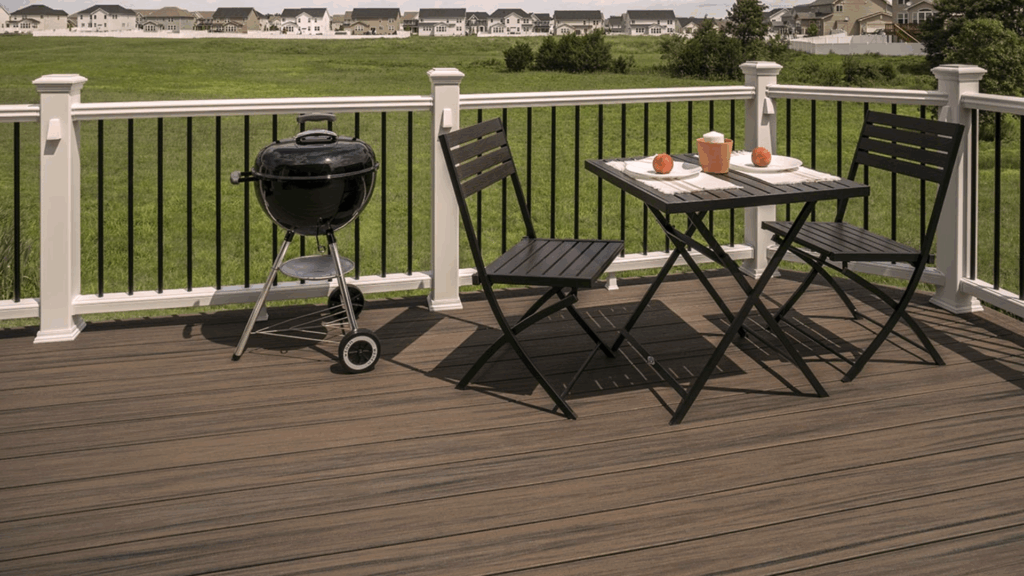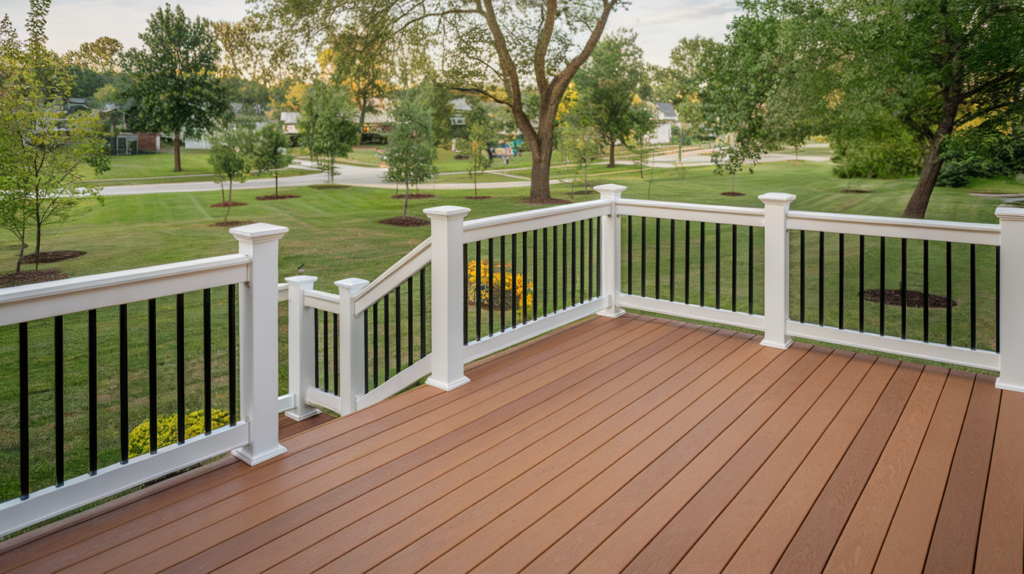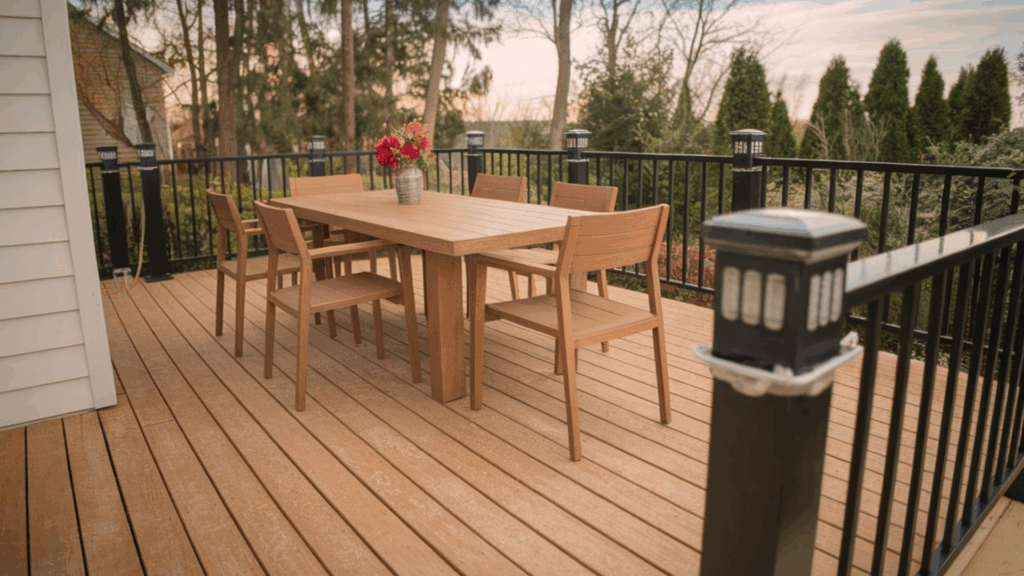Are you sick of spending weekends sanding, staining, and repairing your wooden deck? You’re not alone.
Homeowners everywhere are turning to Trex decking as a smart alternative to traditional wood.
This engineered material promises durability, less maintenance, and a fresh look that lasts for years. But can Trex decking truly stand up to sun, rain, and heavy foot traffic?
In this guide, I’ll break down:
- Actual lifespan expectations
- How Trex compares to wood decking
- Maintenance tips to maximize your deck’s life
If you’re planning a new deck or replacing an old one, I’m here to help you make the best decision for your home.
Ready to learn everything you need to know? Let’s get started.
How Long Does Trex Decking Last?
Trex decking is known for its durability and long lifespan. On average, Trex decks can last 25 to 30 years, depending on factors like climate, maintenance, and installation.
Unlike wood, Trex is made from a combination of recycled wood fibers and plastic, making it resistant to rot, termites, and weather damage.
It doesn’t need regular staining or sealing, which helps it maintain its appearance for years.
However, like any outdoor material, regular cleaning and care are important to keep your Trex deck in good condition.
If installed properly and maintained, Trex can be a low-maintenance, long-lasting addition to your home.
Factors that Affect Trex Decking Lifespan

Not all decks are created equal. Some last longer than others, and it’s not just luck. Let me break down the key factors that determine how long your Trex deck will truly last.
1. Quality of Installation
The way Trex decking is installed can make a big difference in how long it lasts. If the boards are spaced properly and attached securely, they are less likely to warp, shift, or collect moisture.
Poor installation, such as using the wrong fasteners or skipping the manufacturer’s guidelines, can lead to serious problems over time, including rotting frames or loose boards.
Hiring a professional or following detailed DIY instructions helps ensure the deck stays strong and safe for years.
2. Climate and Weather
Trex decking is built to stand up to the outdoors, but the local climate still plays a role in its lifespan. In areas with lots of sun, UV rays can slowly fade the color of the boards.
In wet or humid regions, moisture can build up underneath if there’s not enough airflow, leading to mildew or mold.
Places with freezing temperatures can cause repeated expansion and contraction, which may wear out the deck faster. A covered or shaded deck will usually last longer in harsh weather zones.
3. Type of Trex Product Used
Trex offers several product lines, and each one has different levels of durability.
For example, Trex Transcend is their highest-quality option with the best resistance to fading, staining, and wear. Trex Enhance and Trex Select are more affordable, but they may not last quite as long in high-use or harsh environments.
Choosing the right product for your climate and lifestyle will help your deck hold up better over time and reduce the need for early repairs or replacements.
3. Foot Traffic and Usage
How much activity your deck sees will also affect how long it lasts. A deck that’s used every day for outdoor meals, parties, and pets will wear down faster than one that’s used only occasionally.
Moving furniture, dragging coolers, or frequent grilling can leave marks or wear on the surface. To protect your deck, use furniture pads, outdoor rugs, and keep heavy objects in one place for limited time.
Rotating your furniture setup once in a while helps prevent uneven fading or wear.
How Long Do Other Materials Last?
Composite decking has come a long way since its early days. Today’s high-end brands like Trex, TimberTech, and Fiberon offer boards that last 25 to 30 years with minimal upkeep.
They resist fading, moisture, and wear far better than wood, which typically needs replacing after 10 to 15 years.
On the other hand, PVC decking takes durability even further. Made from 100% plastic, it can last 30 to 50 years, thanks to its resistance to water, rot, and bugs.
It’s nearly maintenance-free but does cost more upfront. Just note – PVC can get hot in full sun.
Overall, both composite and PVC outlast traditional wood, giving you long-term value and less work in the long run.
Trex vs Other Decking Materials: Quick Table
Deck shopping can feel like a maze. Let me break down how Trex stacks up against other materials. Think of this as your cheat sheet for making a smart choice.
| Material | Trex | Pressure-Treated Wood | Cedar/Redwood | PVC |
|---|---|---|---|---|
| Upfront Cost | Moderate | Lowest | High | Highest |
| Lifespan | 25-30 years | 10-15 years | 15-20 years | 30-50 years |
| Maintenance | Minimal | High | Moderate | Minimal |
| Appearance | Consistent | Rough | Natural wood | Synthetic |
| Heat Retention | Moderate | Low | Low | High |
| Rot Resistance | Excellent | Poor | Moderate | Excellent |
| Color Options | Multiple | Limited | Natural | Limited |
How Trex Decking Overcomes Common Lifespan Challenges
Trex decking is designed to last longer than wood by solving the problems that usually shorten a deck’s life.
- Fading and Sun Damage: Trex boards come with built-in UV protection. This helps keep the color from fading, even under strong sunlight. While all outdoor materials change a little over time, Trex holds its look nicely.
- Moisture and Rot: Unlike wood, Trex doesn’t soak up water. Its shell resists moisture, preventing mold, mildew, and rot. This makes it perfect for wet or humid areas where wood decks might break down quickly.
- Staining and Spills: Trex’s protective shell also fights off stains from food, drinks, or dirt. Most spills can be cleaned with just soap and water, making maintenance easy and reducing long-term wear.
- Cracking and Splintering: Trex boards are made from a mix of wood fibers and plastic, creating a strong, smooth surface. They won’t splinter or crack like wood, so you get a safer and more comfortable deck over time.
- Insect Damage: Termites and other wood-eating insects can destroy a wood deck. Trex’s composite core doesn’t attract bugs, so you won’t have to worry about hidden damage or surprise repairs.
Maintenance Tips to Extend Lifespan

A little care goes a long way. Your Trex deck isn’t maintenance-free, but it’s pretty close to it. This is how you can keep it looking brand new for decades.
- Clean It Regularly: Sweep off leaves, dirt, and debris often. Wash your deck every few months using mild soap, water, and a soft brush or cloth. Avoid using bleach or harsh cleaners—they can damage the surface over time.
- Watch for Mold and Mildew: Even though Trex resists mold, moisture trapped under furniture or planters can still cause issues. Use furniture with airflow beneath it and move planters from time to time.
- Avoid Harsh Tools and Chemicals: Don’t use metal shovels or stiff wire brushes – they can scratch the surface. Stick with plastic tools or soft-bristle brooms. Always read the label before using any cleaning product.
- Use Protective Pads: Place rubber or plastic pads under furniture legs and grills. This prevents scrapes and dents, especially if you move items around often. Avoid dragging heavy objects across the boards.
- Trim Nearby Plants and Trees: Overgrown branches can drop leaves, trap moisture, or stain the surface. Keep trees and shrubs trimmed to allow sunlight and airflow around your deck.
- Clear Gaps Between Boards: Make sure there’s no debris stuck between the deck boards. Use a plastic putty knife or soft brush to remove leaves or dirt. This helps with drainage and reduces the chance of mold.
Conclusion
Choosing a deck isn’t just about looks – it’s about making a smart investment for your home. Trex isn’t just decking; it’s peace of mind wrapped in durable materials.
Think about it: 25 to 30 years of outdoor memories without constant maintenance. No more weekend warrior repair sessions. No more worrying about rotting boards or endless staining.
Your deck should be a place of relaxation, not stress. Trex delivers on that promise:
- Minimal upkeep
- Consistent appearance
- Lasting durability
- Weather resistance
Other materials will come and go. Trex stands the test of time. Even if you’re hosting summer barbecues or enjoying quiet morning coffees, your deck should work for you, not the other way around.
If you’re planning a deck that lasts, Trex is built to stick around.

